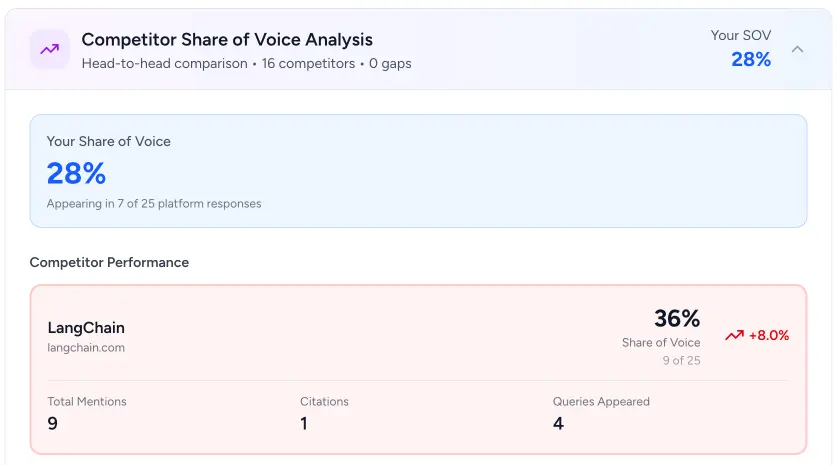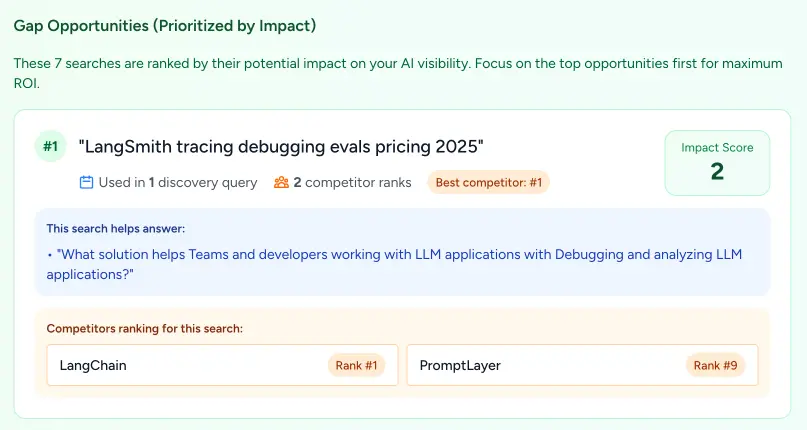Managing Competitors
When someone asks an AI assistant about solutions in your space, does it recommend you, or your competitors? The Competitors feature helps you understand how your brand stacks up against the competition in AI responses.
What You'll Learn
In this guide, you'll learn:
- How to add and manage competitors
- How to view competitor Share of Voice
- How to identify gap opportunities
- How to use competitor data to improve your AI visibility
Why Track Competitors?
AI assistants don't just answer questions about your brand in isolation. When users ask about solutions, AI platforms compare multiple options and often recommend alternatives. Understanding which competitors appear alongside your brand helps you:
- Identify positioning gaps: See which competitors are outperforming you in AI recommendations
- Prioritize optimization efforts: Focus on queries where competitors dominate but you're absent
- Track competitive dynamics: Monitor how your Share of Voice changes relative to competitors over time
- Inform content strategy: Learn what makes competitors visible in AI responses
Adding Competitors
Navigate to your property's Competitors section from the sidebar under Configuration.

To add a competitor:
- Click "Add Competitor"
- Enter the competitor's domain (e.g., competitor.com)
- Optionally provide their brand name if different from their domain
- Click "Save"
Spyglasses will automatically track this competitor in all future AI Visibility Reports.
Automatic Competitor Detection
When you run an AI Visibility Report, Spyglasses analyzes AI responses and identifies brands that appear alongside yours. These automatically detected competitors appear in your list and can be confirmed or removed based on your preferences.
Understanding Share of Voice
Share of Voice (SOV) represents how often your brand appears in AI responses compared to your competitors. It's calculated as the percentage of platform responses where your brand is mentioned out of all possible opportunities.

For example, if you run 5 discovery queries across 5 platforms (25 total responses):
- Your brand appears in 12 responses = 48% SOV
- Competitor A appears in 15 responses = 60% SOV
- Competitor B appears in 8 responses = 32% SOV
What SOV Tells You
- Higher SOV: Your brand is being recommended more frequently than competitors
- Lower SOV: Competitors are dominating AI recommendations in your space
- Improving SOV: Your optimization efforts are working
- Declining SOV: Competitors may be improving their AI visibility faster than you
The SOV data shown in the Competitors section comes from your most recent AI Visibility Report and updates automatically after each report runs.
Viewing SOV in Your Competitor List
The competitor table shows Share of Voice and total mentions for each tracked competitor. This makes it easy to see at a glance which competitors are outperforming you in AI recommendations.
If a competitor shows "No data," it means they haven't appeared in any recent AI Visibility Reports. This could indicate they're not a relevant comparison for your current discovery queries, or they may not be optimized for AI visibility yet.
Customizing Your Competitor List
Editing Competitors
Click the edit icon next to any competitor to:
- Update their domain
- Change their display name
- Add notes about their positioning
Removing Competitors
Click the delete icon to remove a competitor from tracking. This won't delete historical data, but they'll no longer appear in future reports.
When to Update Your Competitor List
Update your competitors when:
- Your competitive landscape changes
- You want to track a new market entrant
- AI reports consistently mention brands you don't have listed
- You're shifting focus to a new market segment
Gap Opportunities
The most valuable insight from competitor tracking is identifying "gap opportunities"—discovery queries where competitors appear but your brand doesn't.
When viewing your AI Visibility Reports, look for the Competitor Analysis section. This shows:
- Overall SOV comparison
- Number of gap queries for each competitor
- Specific queries where each competitor outperforms you

These gaps represent your highest-priority content opportunities. If AI recommends competitors for a query but not you, that's a signal to:
- Create or improve content addressing that query
- Optimize existing content to better match the query intent
- Build authority signals (mentions, links, reviews) for that use case
Using Competitors in Discovery Queries
When you create custom discovery queries, you can reference your competitors to generate more targeted prompts. For example:
- "Compare [Your Brand] vs [Competitor] for [use case]"
- "Alternatives to [Competitor] for [customer segment]"
This ensures your AI Visibility Reports test how AI positions you in direct comparisons.
Best Practices
Limit Your List
Track 3-5 key competitors rather than every possible alternative. Focus on:
- Direct competitors in your core market
- Brands that consistently appear in AI responses
- Companies your prospects mention in sales conversations
Monitor Regularly
Check competitor SOV after each AI Visibility Report. Look for trends over multiple reports rather than reacting to single data points.
Use Multiple Data Sources
Combine competitor SOV data with:
- AI Traffic Analytics to see actual referrals
- Traditional search rankings
- Customer feedback about alternatives they considered
Focus on Gaps
Rather than trying to beat competitors everywhere, focus on high-value queries where they dominate but you're absent. These offer the best return on effort.
How This Ties to AI Search Visibility
Competitor tracking is essential for improving your AI visibility because:
-
AI uses comparative reasoning: When users ask about solutions, AI platforms evaluate multiple options. Understanding who you're compared against helps you position more effectively.
-
Gap analysis drives content strategy: The queries where competitors appear but you don't reveal exactly what content you need to create or optimize.
-
SOV is a leading indicator: Changes in Share of Voice often predict changes in actual AI referral traffic before they show up in analytics.
-
Competitive positioning matters: AI platforms favor brands with clear differentiation. Understanding competitor positioning helps you articulate what makes you unique.
The competitors you track form the baseline for measuring your AI visibility improvements. As you optimize your content and build authority, you should see your SOV increase relative to these competitors, which translates to more AI-driven traffic and leads.